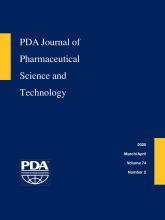Abstract
For manufacturers of both sterile and nonsterile pharmaceuticals, there is an expectation that the manufacturing process is performed in a manner that prevents extraneous contamination so that the products are provided in a safe, integral, pure, and unadulterated form. As part of that process, cleaning and disinfection are an absolute necessity. Although cleaning and disinfection support control of microbial contamination through preventive and corrective action, specific compendia methods do not currently exist. The intent of this paper is to provide a general guidance on how to perform disinfectant efficacy validation and implementation. This includes how to make sure the concepts are understood, how to interpret facility data and utilize it to demonstrate control awareness for your facilities, and how to leverage the data to reduce redundancies in validation or verification. This paper represents the thoughts and best practices of the authoring team and their respective companies and provides an efficient way to qualify disinfectants without impacting the quality of the study. If you choose to follow the recommendations in this paper, you must ensure that the appropriate rationale is sound and the scientific data is documented. It is the belief of the authoring team that only then will this approach meet regulatory requirements.
- © PDA, Inc. 2020
PDA members receive access to all articles published in the current year and previous volume year. Institutional subscribers received access to all content. Log in below to receive access to this article if you are either of these.
If you are neither or you are a PDA member trying to access an article outside of your membership license, then you must purchase access to this article (below). If you do not have a username or password for JPST, you will be required to create an account prior to purchasing.
Full issue PDFs are for PDA members only.
Note to pda.org users
The PDA and PDA bookstore websites (www.pda.org and www.pda.org/bookstore) are separate websites from the PDA JPST website. When you first join PDA, your initial UserID and Password are sent to HighWirePress to create your PDA JPST account. Subsequent UserrID and Password changes required at the PDA websites will not pass on to PDA JPST and vice versa. If you forget your PDA JPST UserID and/or Password, you can request help to retrieve UserID and reset Password below.






